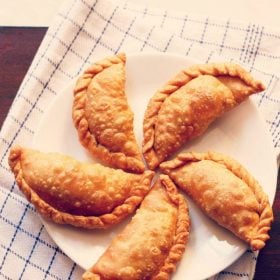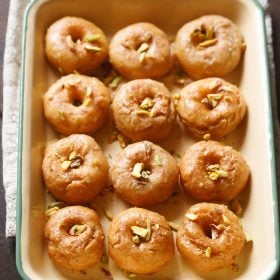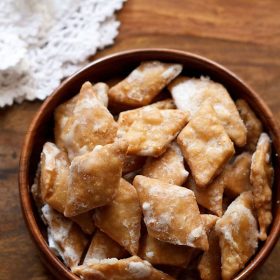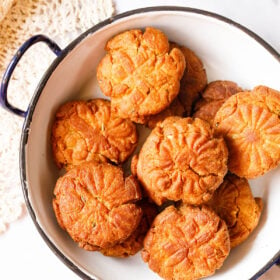Gulgule Recipe | Pua Recipe (Gulgula)
Sweet, tender on the inside, and crispy on the outside, these Gulgule (singular gulgula) are fennel-scented deep-fried balls of deliciousness from the North Indian cuisine. These fluffy, doughnut like treats are soft and fluffy, perfect for serving with your afternoon cup of Chai. These deep-fried sweets are made with whole wheat flour, sugar or jaggery, mashed banana, and fennel seeds. The Gulgule Recipe takes only 25 minutes to make. Also referred to as pua, pooda, or puda in Punjabi, these delightful snacks are well worth every moment of effort.
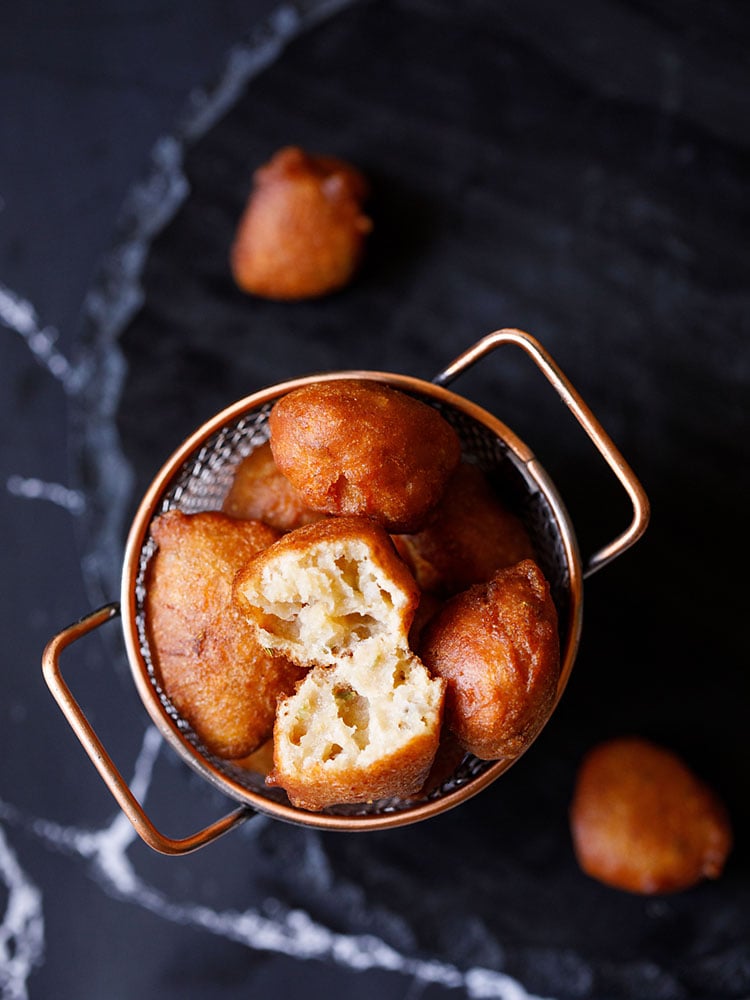

About Gulgule Recipe
There is a special ingredient in this gulgule recipe which gives the final dish a lovely soft texture. Any guesses? Surprise, it’s banana!
If you cook or bake with bananas, you know their immense contribution to the flavor, texture, and taste of your final product. Bananas help give these dainty fried sweets a nice fluffy and soft texture.
No Bananas? Not to worry. You can easily make gulgule without them. You just need to add some more sugar and water while making the batter. I mentioned the details in the notes section of the recipe card toward the end of the post.
I came across this gulgule recipe for the first time about 12 years back when my mother-in-law shared it with me. We were living in Delhi at that time and when it used to rain, we would make these crispy Indian doughnuts for the entire family.
Like many of the recipes on the site, this is a simple recipe. In fact, they only take 5 minutes of prep and 20 minutes of cooking time. You can make them during any festive occasion like Holi, Diwali, Karwa Chauth, or any other celebration you like.
Pua taste especially great in cold, rainy weather, but maybe that’s just because they remind me of wonderful times with my family.
What is the Difference Between Gulgule vs Malpua?
Gulgule has some similarities with Malpua, which is a popular Indian dish of shallow-fried flour pancakes glazed with sugar syrup.
- Malpua is made like a pancake and gulgula are fried like fritters (pakoda) or doughnuts.
- Malpuas are sweeter than gulgule as they are glazed with sugar syrup.
- In gulgule, fennel seeds are added which lends a subtle sweet anise flavor. I also make another variation of this gulgule recipe that is cooked like a pancake.
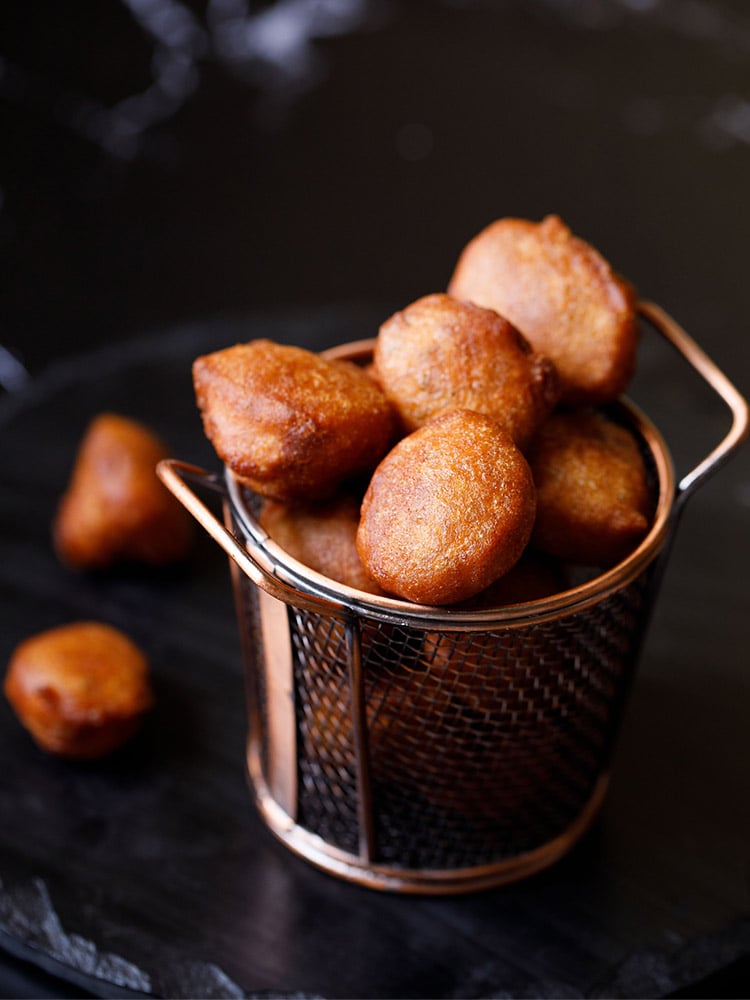

Ingredients & Substitutions
As promised, you don’t need many ingredients to make these gorgeous, golden gulgule. Here is what to grab:
- Bananas – Adding bananas is optional. Bananas give a nice soft texture and hence I add them. If you do not add bananas, you can add about ½ cup sugar and a bit more water.
- Raw Sugar, White Sugar or Jaggery – For sweetener; add according to taste. Please note that I think these pua taste especially good with jaggery!
- Whole Wheat Flour – I prefer using nutty-flavored whole wheat flour not only because it is healthier, but also because it is delicious. If needed you can swap in regular all-purpose flour.
- Fennel Seeds (Saunf) – For a faint, sweet anise flavor.
- Green Cardamom Powder – Optional, but having a fragrant aroma.
- Salt – For seasoning. I used pink salt. You can use regular salt or sea salt.
- Baking Powder – For leavening. Feel free to add up to 1 teaspoon for a fluffier result. You can also omit it entirely if you prefer.
- Water – For the best flavor, use filtered water.
- Oil – For deep-frying. Use any neutral-flavored, high smoke point oil you prefer (e.g. sunflower, or avocado). You can also make these with less oil by using an Appe (aebleskiver) pan.
Step-by-Step Guide
How to make Gulgule (Pua)
Find below detailed instructions with photos on how gulgule or pua is made.
Make Batter
1. Take ½ cup chopped bananas and 6 tablespoons raw sugar in a bowl. You can also use white sugar or jaggery.
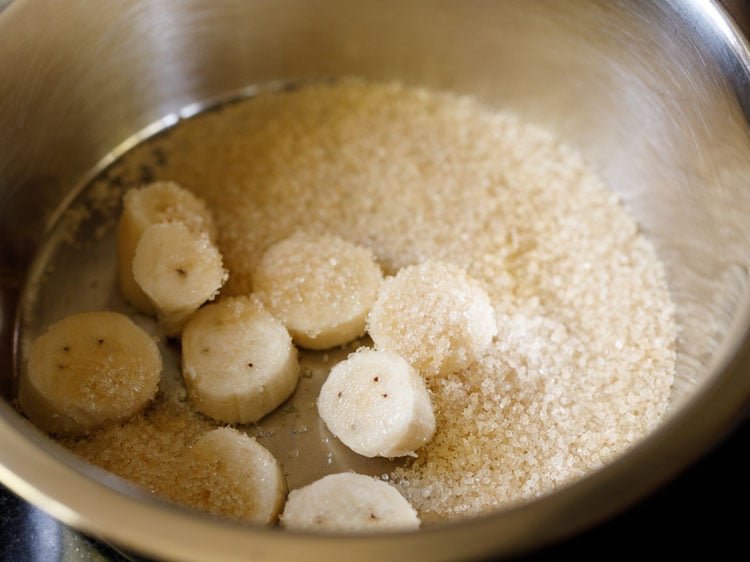

2. Mash very well with a fork or vegetable masher. Mix the sugar with the bananas as you go on mashing.
Make sure that the sugar dissolves as you go on mashing the bananas.
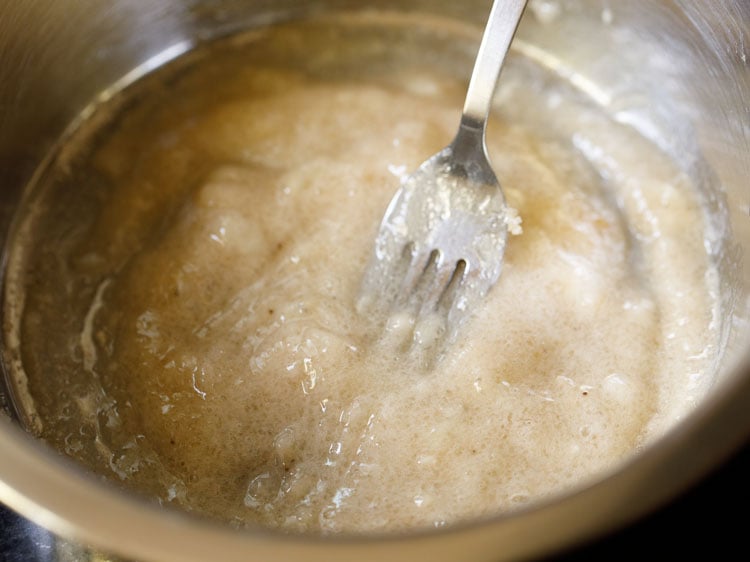

3. Add the following list of ingredients to the mashed banana and sugar mixture.
- 1 cup whole wheat flour
- 1 teaspoon fennel seeds
- ¼ teaspoon green cardamom powder
- ½ teaspoon baking powder
- 1 pinch of salt
You can sift the flour if you want.
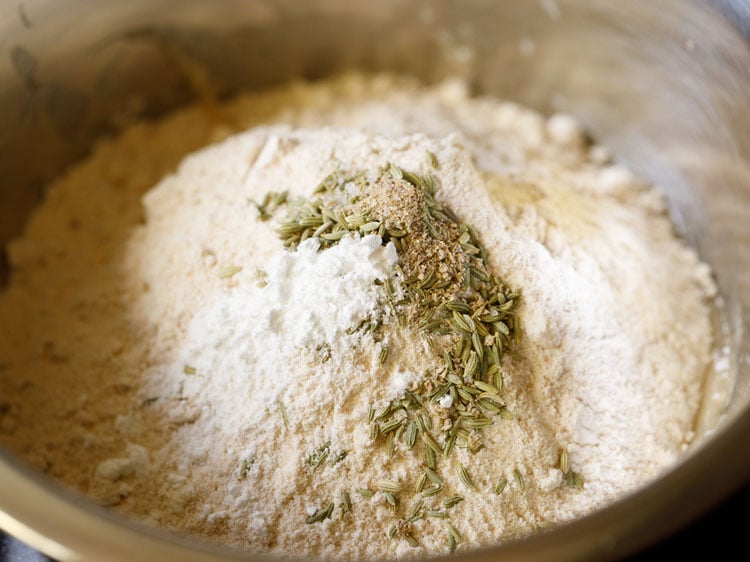

4. Add just ½ cup of the water.
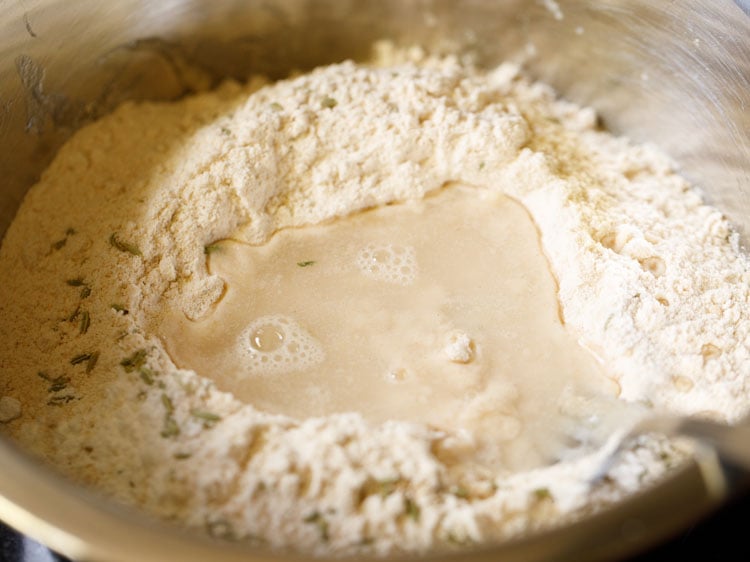

5. Begin to mix. Then add more water if needed to make a batter which is neither too thick nor too thin. The batter should be slightly thicker than a pakoda batter.
If the flour is finely ground, then less water will be needed. If the flour is coarse, then more water will be needed.
Overall you may need to add from 8 to 11 tablespoons water. I had used a slightly coarse flour and added 11 tablespoons of water. Note that 8 tablespoons water is ½ cup of water.
Do not over mix as this may lead to the formation of gluten in the batter which will result in a denser texture.
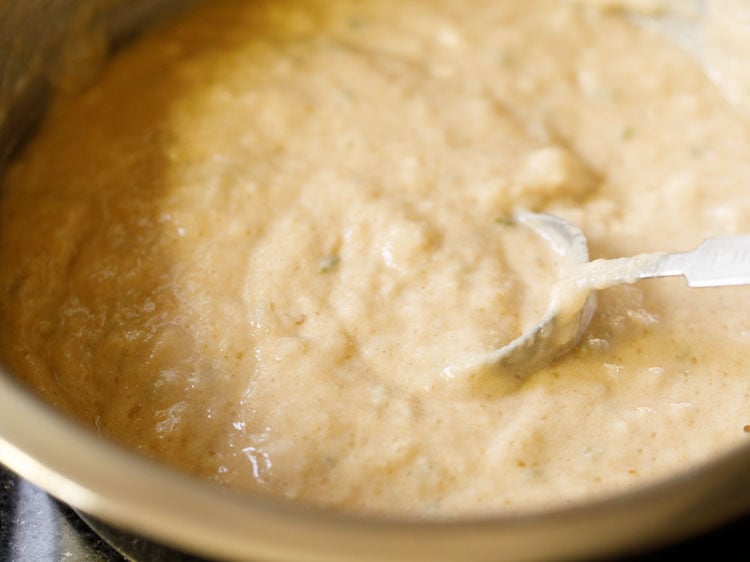

Fry Gulgule
6. In a heavy-bottomed deep pan, wok, or kadai heat oil. Let the oil become hot.
Test a small portion of the batter in the oil. If the portion rises steadily through the oil, then you can begin to fry.
Note that the oil should be hot (approximately 177-190 degrees C or 350-375 degrees F), otherwise, the batter may stick to the kadai.
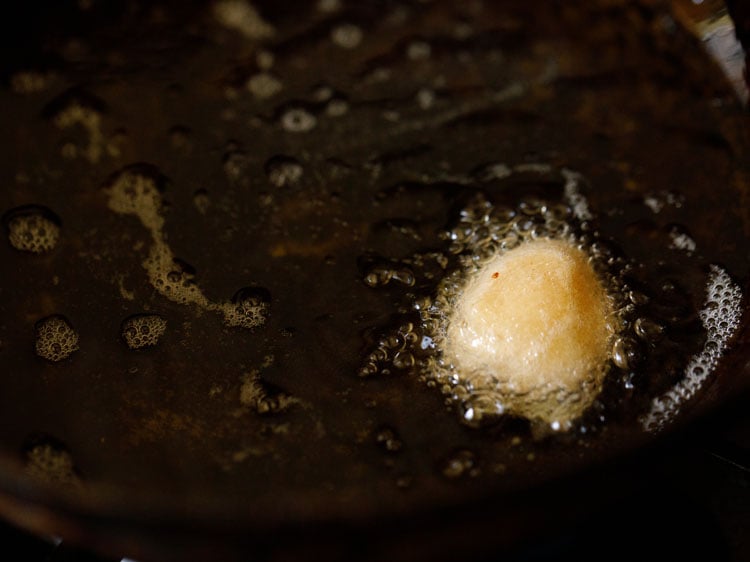

7. Add spoonfuls of the batter to the oil. Fry on a medium heat.
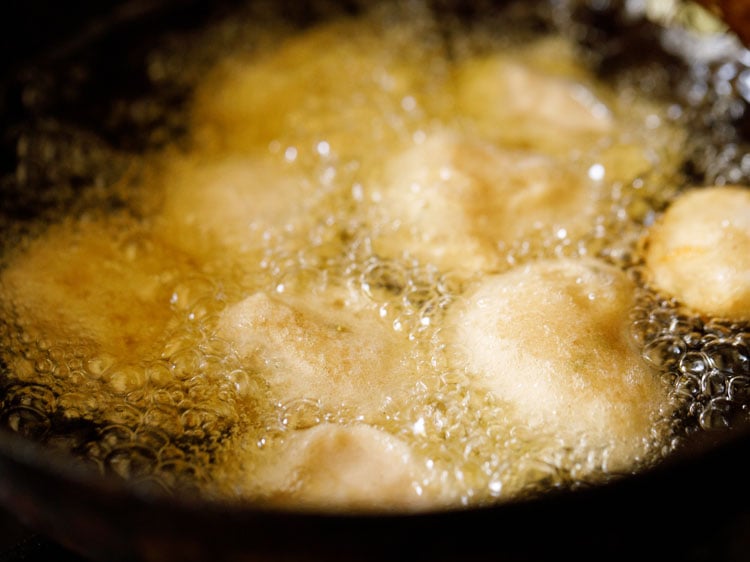

8. Let the gulgule become light golden from the bottom and sides, then gently turn over each gulgula. The gulgule will puff while frying.
Keep in mind that the oil should not be very hot, otherwise the gulgule may get burnt.
Do not overcrowd the pan. You can easily fry 8 to 12 gulgule at a time depending on the size of the pan or kadai.
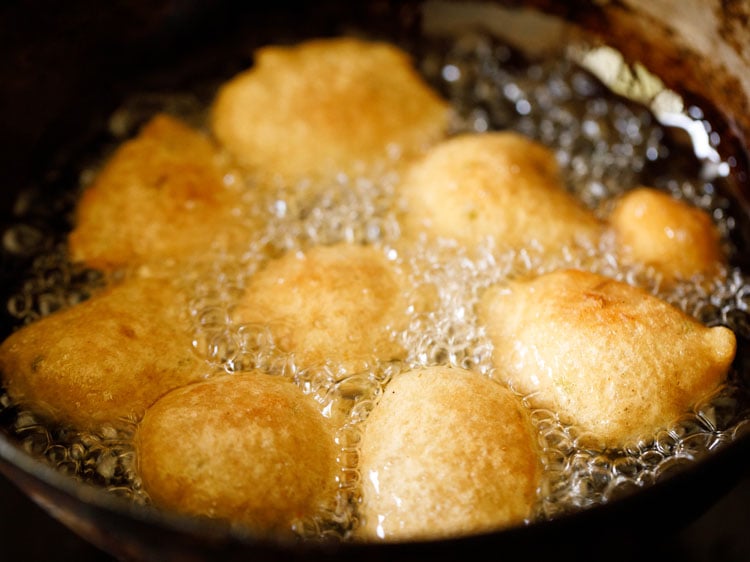

9. Keep turning for even frying till they are crisp and golden. If you do not want to deep fry, then you can also make these in an appe pan (aebleskiver pan).
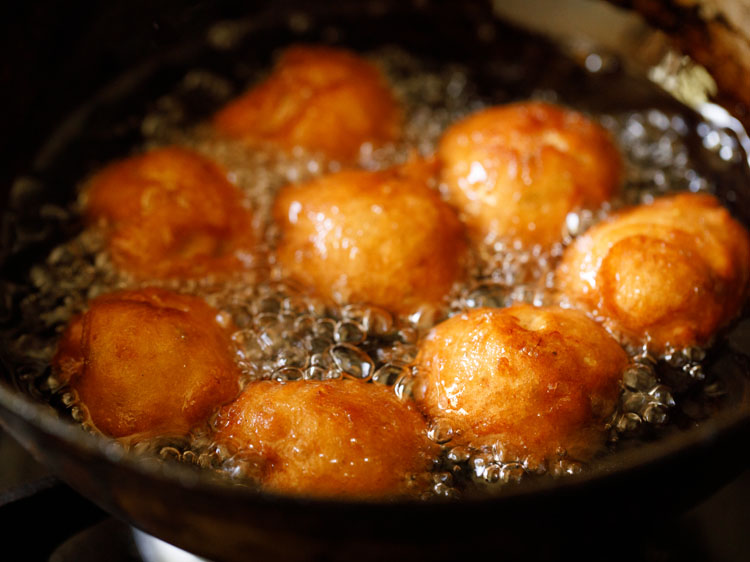

10. Once they are golden brown, remove them with a slotted spoon and place on kitchen paper towels to drain.
Fry the remaining gulgule in this manner in a total of 2 to 3 batches.
Note that bananas will give a dark brown hue to the fritters. The sugars in the bananas caramelize when frying giving a dark golden color. If the fritters begin to get too browned or burnt, then lower the heat.
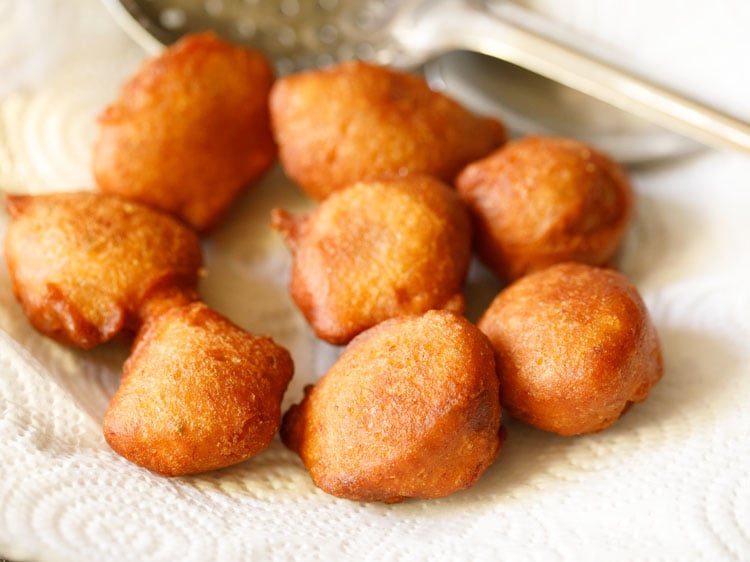

11. Serve Gulgule or Pua hot with Masala Chai or Ginger Chai.
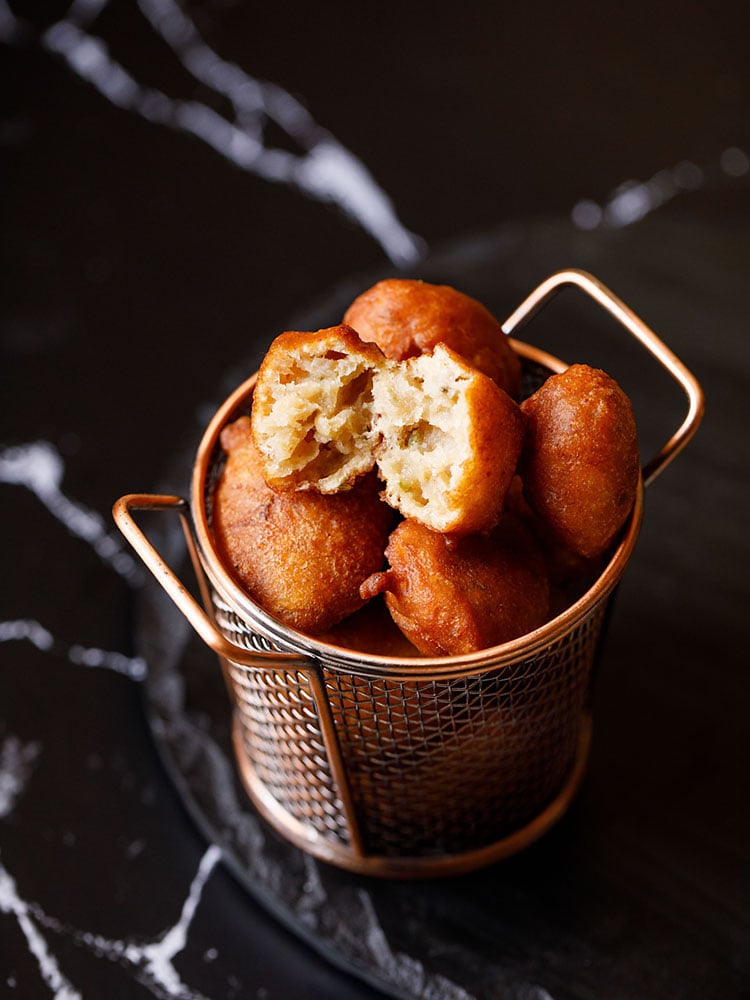

Serving Suggestions
Mostly I make these as a tea-time snack. We usually have them with chai. You can even serve them with Rabri (sweetened thickened milk) or Rice Kheer. You can even make these as an after school snack for kids.
Expert Tips
- Do not over-mix the batter, which can cause the production of gluten, which will ultimately result in a dense texture.
- If the flour is finely ground, then less water will be needed. Overall, you’ll need to add 8 to 11 tablespoons water. (8 tablespoons water is ½ cup of water.)
- Note that the oil should not be too hot, otherwise they will get burnt. If the oil is too hot, then the outside part will darken and brown quickly but the inside will be undercooked. On the other hand, if the oil is too cold, it will cause the gulgule to stick to the bottom of the kadai. You are aiming for a temperature of 177-190 degree C (350-375 degrees F).
- Do not overcrowd the pan. You can easily fry 8 to 12 gulgule at a time depending on the size of the pan or kadai.
- For a fluffier texture, you can add 1 teaspoon of baking powder in step 3.
- You can also cook the pua or gulgula in a paniyaram pan or appe pan. You could also opt to use ghee to fry the pua if you prefer.
More Fried Indian Sweets
Sweets Recipes
Sweets Recipes
Sweets Recipes
Sweets Recipes
Please be sure to rate the recipe in the recipe card or leave a comment below if you have made it. For more vegetarian inspirations, Sign Up for my emails or follow me on Instagram, Youtube, Facebook, Pinterest or Twitter.
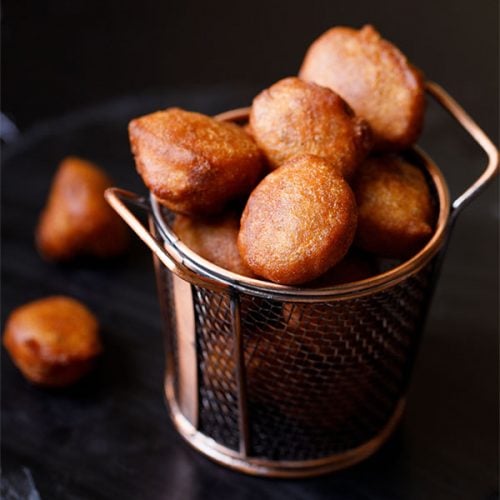

Gulgule Recipe | Pua Recipe (Gulgula)
Gulgule (singular Gulgula) are crispy, fluffy, soft, fried Indian doughnuts made with whole wheat flour, banana, sugar or jaggery and fennel seeds. It is a special and unique sweet from the North Indian cuisine and is also referred to as pua, pooda, or puda in Punjabi.
Prep Time 5 minutes
Cook Time 20 minutes
Total Time 25 minutes
Prevent your screen from going dark while making the recipe
Making batter
Take chopped bananas and sugar in a mixing bowl. Mash very well with a fork or vegetable masher. Mix the sugar with the bananas as you go on mashing and ensure that the sugar granules dissolve.
Add the wheat flour, fennel seeds, cardamom powder and salt to the mashed banana and sugar mixture.
- Add half a cup of water first. Mix well and add more water if required to make a batter that is neither too thick nor too thin. Check the point no 1 in the notes section of this recipe card for tips on batter consistency and adding water.
The batter should be slightly thicker than a pakoda batter.
Frying gulgule
In a deep pan or wok or kadai heat oil. Let the oil become hot.
Drop spoonfuls of the batter in the hot oil. Fry the gulgule on a medium heat.
Note that the oil should not be less hot, otherwise the batter may stick. The oil should also not be very hot, otherwise the gulgule may get burnt.
- Do not overcrowd the pan. You can easily fry 8 to 12 gulgule at a time depending on the size of the pan or kadai. While frying if the oil becomes too hot, then reduce the heat.
The gulgule will puff while frying. When one side is light golden, gently turn over and fry the other side.
Keep on turning and frying them till they are golden brown. Remove them and place on kitchen paper towels for the extra oil to be absorbed.
When frying, they may stick, but get separated once browned.
Serve the Gulgule or Pua hot or warm with Indian chai.
- Batter consistency: First add half a cup of water. Begin to mix and then add more water as and if required in parts to make a medium thick batter. The batter should be slightly thick than pakoda batter. If the flour is finely ground, then less water will be needed. If the flour is coarse, then more water will be needed. Overall you may need to add from 8 to 11 tablespoons water. I had used a slightly coarse flour and added 11 tablespoons water.
- Spices: Fennel seeds are essential and cannot be skipped. But you can skip green cardamom powder.
- Frying: Fry on medium heat. Do not fry on a high heat. Since bananas are added, the browning will be darker. The sugars in the bananas caramelize when frying giving a dark golden color. If the fritters begin to get too much browned, then lower the heat. If the oil is too hot, then the outside part will darken and brown quickly but the inside will be undercooked.
- Bananas: Adding bananas is optional. Bananas give a nice soft texture and hence I add them. If you do not add bananas, you can add about ½ cup sugar and a bit more water.
- Baking powder: If you do not prefer baking powder in your sweets, then you can easily skip them. I make gulgule without baking powder too – taste wise they are good but the texture is less soft. Alternatively, for a more fluffy texture, you can add 1 teaspoon baking powder instead of ½ teaspoon baking powder.
- Sweeteners: You can even use jaggery (non centrifugal indian unrefined sugar) in place of raw sugar or refined sugar.
- Scaling: This gulgule recipe can be easily halved or doubled.
Nutrition Facts
Gulgule Recipe | Pua Recipe (Gulgula)
Amount Per Serving
Calories 255 Calories from Fat 72
% Daily Value*
Fat 8g12%
Saturated Fat 1g6%
Sodium 14mg1%
Potassium 227mg6%
Carbohydrates 44g15%
Fiber 4g17%
Sugar 20g22%
Protein 4g8%
Vitamin B1 (Thiamine) 1mg67%
Vitamin B2 (Riboflavin) 1mg59%
Vitamin B3 (Niacin) 2mg10%
Vitamin B6 1mg50%
Vitamin C 2mg2%
Vitamin E 3mg20%
Vitamin K 1µg1%
Calcium 38mg4%
Vitamin B9 (Folate) 17µg4%
Iron 1mg6%
Magnesium 48mg12%
Phosphorus 146mg15%
Zinc 1mg7%
* Percent Daily Values are based on a 2000 calorie diet.
This Gulgule recipe from the archives was first published on August 2009. It has been updated and republished on November 2023.
[ad_2]


